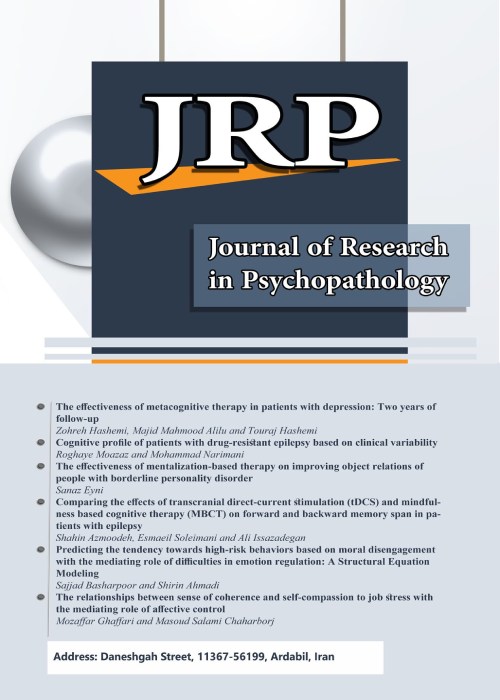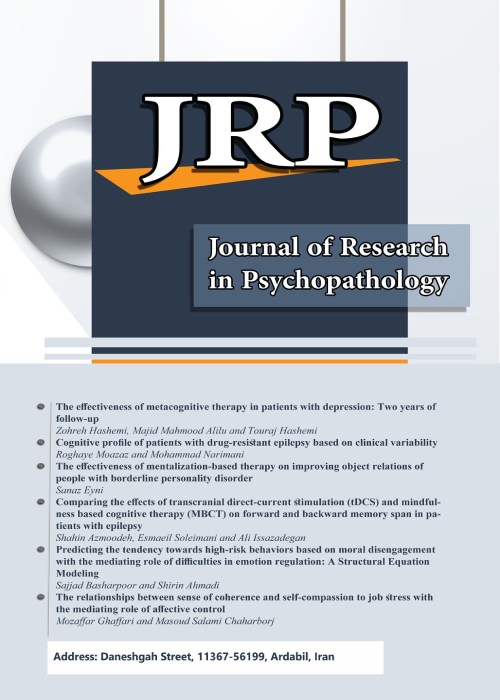فهرست مطالب

Journal of Research in Psychopathology
Volume:4 Issue: 12, Spring 2023
- تاریخ انتشار: 1402/03/23
- تعداد عناوین: 6
-
-
Pages 1-8High-risk behaviors are defined as acts that increase the likelihood of physical, psychological and social disastrous consequences for the individuals. The aim of this study was to evaluate the effectiveness of compassionate mind therapy on cognitive deficits and emotional processing deficits among adolescent soldiers aged 18 to 20 years old with high-risk behaviors. The method of the present study was quasi-experimental with pre-test and post-test design. The population included all adolescent soldiers aged 18 to 20 years who referred to Valiasr Medical Center in Tehran in 2020. The sample consisted of 30 soldiers with high-risk behaviors who were purposefully selected among those who had completed the consent form based on entry and exit criteria. The selected individuals were randomly divided into two groups (15 people in each group). In order to collect data, Iranian adolescents’ risk-taking questionnaires, Cognitive Failures Questionnaire and Toronto Alexithymia scale were used. The experimental group was trained for eight sessions of compassion treatment and the control group did not receive any treatment. The data were analyzed using multivariate analysis of covariance and SPSS-23 software. The results showed that compassion-based therapy reduced cognitive deficits (p < .01) and emotional processing deficits (p < .05). According to the results of the present study, employing compassionate practice and increasing positive emotions can expand an individual’s behavioral-intellectual treasury, pave the way for successful problem solving, reduce negative intra-individual emotions, provide interpersonal skills, and thus reduce risky behaviors.Keywords: Compassionate mind-based therapy, cognitive deficits, emotional processing deficits, high risk behaviors
-
Pages 9-16The present study aimed to investigate the effectiveness of motivational enhancement therapy on addiction treatment barriers and attitudinal ambivalence towards addiction. This study is quasi-experimental research with a pretest-posttest control group design. The population included addicts who were referred to addiction treatment centers in Rasht city in 2022. Seventy-four drug-addicted army conscripts were recruited by convenience sampling and were randomly assigned to two experimental and control groups. The Barriers to Treatment Inventory (BTI) and the Attitudinal Ambivalence Scale were used to measure views on addiction treatment barriers and attitudinal ambivalence towards addiction. Motivational enhancement therapy was provided for the experimental group participants in nine sessions. In the end, the data analysis was done by multivariate analysis of covariance (MANCOVA) using SPSS.24 software. MANCOVA results indicated that motivational enhancement therapy significantly affects views on barriers to treatment and attitudinal ambivalence towards addiction (p < 0.001). Having motivation in any work can be effective, but if these motivations are not well managed and controlled, they bring many harms and dangers to the individual and the society. It should be acknowledged that motivational components play a very colorful role in the beginning, continuation, withdrawal, and return of addiction. In this regard, investigating motivational interventions related to addiction is of great importanceKeywords: Addiction, Motivation, Ambivalence, Treatment
-
Pages 17-23Recognizing the factors affecting self-injurious behaviors of people with a borderline personality disorder is of great importance in prevention and treatment of this disorder. The aim of this study was to determine the role of affective-emotional temperament in predicting self-injurious behaviors in people with a borderline personality disorder. The present study was conducted using a descriptive correlational design, the population of which included all prisoners with borderline personality disorder in the central penitentiary of Karaj in the summer of 2015. After selection by screening, 224 people out of the population participated in this study. These individuals were then interviewed in a structured clinical interview for borderline personality disorder (SCID-II), and finally, after confirming their diagnosis, they were asked to answer questionnaires of affective-emotional temperament and self-harm behaviors. The obtained data was also analyzed using Pearson correlation tests and multiple regression analysis. The results of the Pearson correlation test showed that while there is a positive correlation between self-injurious behaviors and depressed, anxious, cyclothymic, bored, quirky, obsessive, excited, irritable, and uninhibited temperaments, the correlation between self injurious behaviors and indifferent, lively, and euphoric emotional temperaments was a negative one; Moreover, self-inflicted behaviors have a positive relationship with the emotional temperament of volition and anger, while presenting a negative relationship with inhibition, sensitivity, coping, control and desire. The results of regression analysis in about 95% of the total variance of self-injurious behaviors is explained by affective temperament and 47% of its total variance is explained by emotional temperament. These results indicate that affective-emotional temperament can predict self-injurious behaviors in people with borderline personality disorder. Therefore, in the prevention and treatment of borderline personality disorder, it is recommended to study the temperamental components.Keywords: Emotional- affective temperament, Self-injurious behaviors, Borderline personality
-
Pages 24-30Depression is one of the most common psychological symptoms in the elderly. The present study aimed to evaluate the effectiveness of psychological care program in reducing depression in the elderly. The present study is fundamental-applied research in terms of aim and is considered as quasi-experimental research. The population of the study consisted of all elderly with depression symptoms living in nursing homes in Tehran. The sample was purposefully selected to be 30 people. They were divided into two groups of experimental and control (15 people in each group). The instruments used in this study were the Beck Depression Inventory II (BDI-II) and the Elderly Psychological Care Program. First, all the participants in the experimental and control groups completed the BDI-II, and then the educational intervention was implemented by the intervener on the experimental group during seven sessions based on the elderly psychological care program, and the control group did not receive any intervention. In the posttest phase, both experimental and control groups were tested again through BDI-II. The results of one-way analysis of covariance showed that seven-session training of psychological care program was significantly effective in reducing depression in the elderly. Psychological care program creates new behaviors by activating all cognitive, physical and emotional components of neural pathways and by teaching the skills, it provides a framework for understanding emotional experiences. Also, it reduces depression in the elderly and increases their quality of life by increasing motivation to participate and change.Keywords: Psychological Care, elderly, Depression Problems, quality of life, Motivation to participate
-
Pages 31-38The general aim of the present study was to determine the effectiveness of acceptance and commitment therapy on feelings of inferiority, fear of body image, and feeling of self-worth in cosmetic surgery applicants. The current research is fundamentally applied in terms of its purpose, and semi-experimental in terms of design. It was a pre-test-post-test design with a control group. To collect data from the demographic checklist, the Multidimensional Self-Body Relationships Questionnaire (MBSRQ), the Inferiority Scale, and the Contingencies of Self-Worth Scale (CSWS) were used. The population under study included 58 people who visited the cosmetic surgery clinic in Mahabad city in 1401 for cosmetic surgery during a period of one month. The sample size in this research was 12 people in the control group and 12 people in the experimental group. The sampling method was convenience sampling. The experimental group (8 sessions of 45 minutes) underwent acceptance and commitment therapy, and the control group did not receive any treatment. The analysis showed that the components of self-worth, feeling of inferiority, and fear of body image of the experimental groups (the group that was exposed to the treatment method of acceptance and commitment) in the post-test are significantly different from the control group. The eta square indicated that a high amount of the variance of the components of self-worth (24.6%), feeling of inferiority (73.3%), and body image (36.2%) can be explained by the treatment method of acceptance and commitment. The results showed that acceptance and commitment therapy is effective on feeling of inferiority, fear of body image and, feeling of self-worth. Based on these findings, it is recommended to use this method to reduce the fear of body image and feeling of inferiority, as well as increase self-worth in people applying for cosmetic surgery.Keywords: Acceptance, Commitment Therapy, Feeling of Inferiority, fear of body image, feeling of self-worth, cosmetic surgery applicants
-
Pages 39-47The use of the Internet and social media has become an integral part of our daily lives; however, excessive use of these tools can lead to many psychological and social consequences. This study aimed to design a structural model for social media addiction (SMA) based on the dark triad of personality (DTP) and through the mediating role of student social comparison. In this descriptive-correlational study, structural equation modeling (SEM) was used to collect the data. The population consisted of all second-year high school students studying in Kazerun County in the academic year of 2021-2022 (N=5200), of whom 384 individuals were selected as the sample using cluster sampling. The data were collected using the Short Dark Triad Scale (SD3; Jones & Paulhus, 2014), the Social Media Addiction Scale (Tutgun Ünal and Deniz, 2015), and the Adolescent Social Comparison Scale-Revised (ASCS-R; Xavier et al., 2014). The collected data were then analyzed in SPSS 26 and AMOS 24. The SEM results showed that the variable of DTP explains 21% of the variance of social comparison. In addition, variables of DTP and social comparison were found to explain 28% of the variance of SMA. The researchers offer suggestions for future studies based on the theoretical and practical findings on the concepts of SMA, DTP, and social comparison.Keywords: Dark triad of personality, social comparison, social media addiction, Students


